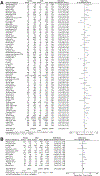Risk Factors for Abdominal Pain-Related Disorders of Gut-Brain Interaction in Adults and Children: A Systematic Review
- PMID: 35716771
- PMCID: PMC9509486
- DOI: 10.1053/j.gastro.2022.06.028
Risk Factors for Abdominal Pain-Related Disorders of Gut-Brain Interaction in Adults and Children: A Systematic Review
Abstract
Background & aims: Many studies have assessed risk factors of irritable bowel syndrome (IBS) and other abdominal pain-related disorders of gut-brain interaction (AP-DGBI); however, the role of these factors is unclear due to heterogeneous study designs. The aim of this systematic review was to extensively evaluate the literature and determine clinical risk and protective factors for the presence and persistence of AP-DGBI in children and adults.
Methods: A PubMed search identified studies investigating potential risk and protective factors for AP-DGBI in adults and children. Inclusion criteria included fully published studies with a control group; exclusion criteria included poor-quality studies (using a validated scale). For each factor, the proportion of studies that found the factor to be a risk factor, protective factor, or neither was summarized. The number of studies, diagnostic criteria, number of subjects, and average study quality rating provided further context. Whenever possible, a meta-analysis generated pooled odds ratios or mean difference.
Results: The systematic review included 348 studies. Female sex, gastroenteritis, abuse, stress, psychological disorders, somatic symptoms, and poor sleep were consistent risk factors for developing AP-DGBI in adults and children. In adults, additional risk factors included obesity, smoking, and increased use of medical resources. Protective AP-DGBI factors in adults included social support and optimism; no studies for protective factors were found for children.
Conclusions: There are multiple risk factors for AP-DGBI in adults and children. These include female sex, gastroenteritis, abuse, stress, poor sleep, obesity, psychological disorders, and somatic symptoms. Additional studies are needed in children, on protective factors, and on factors associated with persistence of AP-DGBI.
Keywords: Functional Gastrointestinal Disorders; Irritable Bowel Syndrome; Recurrent Abdominal Pain.
Copyright © 2022 AGA Institute. Published by Elsevier Inc. All rights reserved.
Conflict of interest statement
Conflicts of interest
These authors disclose the following: Laurie Keefer is on the Rome Foundation Board of Directors. Lin Chang is a member of Rome Foundation Board of Directors, and has received grant funding from National Institutes of Health (U54 DK123755). The remaining authors disclose no conflicts.
Figures







References
-
- Drossman DA. Functional gastrointestinal disorders: history, pathophysiology, clinical features and Rome IV. Gastroenterology 2016;150:1262–1279.e2. - PubMed
-
- Mearin F, Lacy BE, Chang L, et al. Bowel disorders. Gastroenterology 2016;150:1393–1407.e5. - PubMed
-
- Lovell RM, Ford AC. Global prevalence of and risk factors for irritable bowel syndrome: a meta-analysis. Clin Gastroenterol Hepatol 2012;10:712–721.e4. - PubMed
-
- Sperber AD, Bangdiwala SI, Drossman DA, et al. Worldwide prevalence and burden of functional gastrointestinal disorders, results of Rome Foundation global study. Gastroenterol 2021;160:99–114.e3. - PubMed

